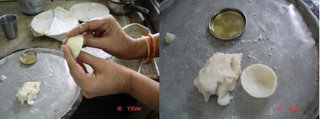 My mother's entry to JFI-Flour hosted by Santhi
My mother's entry to JFI-Flour hosted by SanthiLast Sunday was Naga Panchami (also known as Garuda Panchami in our house) and my mother made the kozhakattai as part of the naivedyam. She has sent me the recipe and the photos on time for the JFI-FLOUR event hosted by Santhi. Garuda Panchami is similar to the Rakhi festival in
Filling/Poornam # 1 : coconut poornam
- 1 cup - Coconut, grated
- 1 ½ cup -Jaggery (2 if you want it even sweeter)
- ½ cup - -Til/Sesame seeds/nuvvulu
- ½ cup - Jaggery
- 1 cup -Rice flour
- 2 cups - Water
- pinch of salt
- ½ tsp - Oil ( preferably sesame seed/gingili oil)
Procedure:
- Coconut Poornam:
Freshly grated coconut is the best for making the coconut filling. Take a wide pan and toss in the coconut and jaggery and stir till the mixture thickens and starts leaving the sides of the pan. Add the elaichi powder and stir for another half a minute. Transfer the mixture to a bowl and allow it to cool. Freshly grated coconut gives this filling its best taste.

- Nuvvula Poornam:
Dry roast the sesame seeds till they turn a slight brown. the seeds let out a winderful aroma as you roast them. Cool the sesame and coarsely powder it in a blender. Add fine pieces of jaggery to this and powder.

- Dough:
In a kadai/vessel bring two cups of water to a boil, add a pinch of salt and 3-4 drops of oil to the water. Once the water comes to a boil, gradually add the rice flour. Hold the ladle in the center of the vessel while adding the flour and then stir continuously for 3 mins on a low flame and then turn off the heat. When the dough is still hot, transfer it to a plate and cover with a wet cloth and knead well to remove any lumps. The wet cloth is to shield your palms from the heat.

- Kozhakattai:
Have some oil in cup and grease your hands as you make the kozhakattai. Take a lime sized ball of the dough and shape it into a cup with your fingers. First slightly flatten the ball on your palm like a disk, place your thumbs at the center of the disk, and the fingers on the outside and shape like a cup by moving the dough between your fingers.

- Put a spoon of the filling into the cups and seal it with the dough. You can either make them round or oval in shape.

- Steam cook the dumplings and serve.
~ Sevai ~
The kozhakattai dough can also be used to make rice noodles or Sevai. Divide the dough into balls and steam cook it for 5-6 mins. When they are still hot, place them in a murukku maker with a fine holed mould and shape them like murukkus. Top them with the til poornam and some ghee.


You can also make lime and coconut sevai, recipe here. Follow the same method you use to make lime rice or coconut rice, but use the rice noodles instead. Sevai are a wonderful and very healthy breakfast/tiffin item. The variations you can try with them are clearly left to your imagination. Do try them out, I promise you will fall in love with them !!
For the Sevai, if you want to try them out with out getting into the dough making process you can look for rice noodles in the Indian grocery stores or in the pasta section in the stores. You just need to boil them in some water just like pasta, but for a shorter period of time. You can then flavor the noodles to your liking.
If you have extra filling, shape them into mini ladoo's for an additional neivedyam item.
This recipe is also my entry to Anthony's Curry Mela this week :-)











































 Going with the combo recipe I had in my previous post. Here is another wonderful combo. Sodhi is a very simple recipe. Its just what the title says it is 'cabbage cooked in coconut milk', it needs no extra spices to give taste to it. It might sound like a weird combination but trust me, the two of them blend beautifully. They have a mild but unique flavor and when used together they are wonderful. Well, but they are NOT the duo in the combo I was talking about. Sodhi served with fluffy hot puri's is one of the best combos I have had. You have to taste it to vouch for it as the taste is nothing like any of the other combo's we are used to !!
Going with the combo recipe I had in my previous post. Here is another wonderful combo. Sodhi is a very simple recipe. Its just what the title says it is 'cabbage cooked in coconut milk', it needs no extra spices to give taste to it. It might sound like a weird combination but trust me, the two of them blend beautifully. They have a mild but unique flavor and when used together they are wonderful. Well, but they are NOT the duo in the combo I was talking about. Sodhi served with fluffy hot puri's is one of the best combos I have had. You have to taste it to vouch for it as the taste is nothing like any of the other combo's we are used to !! Anyone who has tasted this dish before, do tell me...none of my friends heard of it !!! :-(
Anyone who has tasted this dish before, do tell me...none of my friends heard of it !!! :-(


